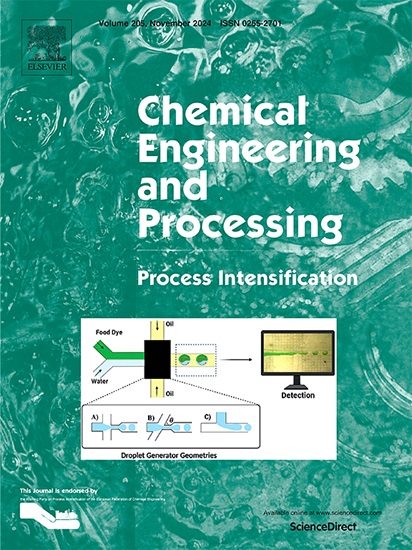Modelling and optimization of spent mushroom substrate valorization into humic-like substances through alkaline extraction intensified by ultrasound
IF 3.8
3区 工程技术
Q3 ENERGY & FUELS
Chemical Engineering and Processing - Process Intensification
Pub Date : 2025-03-05
DOI:10.1016/j.cep.2025.110261
引用次数: 0
Abstract
The present study aimed to assess the possibility of humic-like substances (HSLs) isolation from spent mushroom substrate (SMS) through alkaline extraction intensified by ultrasound. The Box-Behnken design (BBD) coupled with the response surface methodology (RSM) was applied for the process evaluation. Based on the polynomial model, the values of NaOH concentration, process time, and temperature values were selected to maximize the extraction efficiency. The coefficient of determination for the created model was 97.61 %, and the experimental verification of the response showed that the extraction efficiency under optimal process conditions was equal to 32.66 % ± 1.26 %. Obtained humic-like substances were fractionated into humic-like acids (HLAs) and fulvic-like acids (FLAs) and qualitatively assessed. The ATR-FTIR and CP/MAS 13C NMR spectra of the isolated samples revealed the presence of aliphatic, aromatic, carboxyl and carbonyl structures, which were also evident for the humic and fulvic acids extracted from peat and lignite. Furthermore, HLAs and FLAs were characterized by lower concentrations of heavy metals compared to samples isolated from peat and lignite, which combined with a significant content of micro and macronutrients may indicate the potential to use humic-like and fulvic-like acids extracted from the spent mushroom substrate for agricultural purposes.

超声强化碱法提取废蘑菇底物转化为腐植酸样物质的建模与优化
本研究旨在探讨超声强化碱性提取法从废蘑菇底物(SMS)中分离腐殖质样物质(hsl)的可能性。采用Box-Behnken设计(BBD)结合响应面法(RSM)进行工艺评价。基于多项式模型,选取NaOH浓度、处理时间、温度等参数,使萃取效率最大化。建立的模型的决定系数为97.61%,实验验证表明,最优工艺条件下的提取效率为32.66%±1.26%。将获得的腐植酸样物质分为腐植酸样(HLAs)和黄腐酸样(FLAs)并进行定性评价。分离样品的ATR-FTIR和CP/MAS 13C NMR显示了脂肪族、芳香族、羧基和羰基结构,从泥炭和褐煤中提取的腐植酸和黄腐酸也有明显的结构。此外,与从泥炭和褐煤中分离的样品相比,HLAs和FLAs的重金属浓度较低,这与微量和宏量营养素的显著含量相结合,可能表明从废蘑菇基质中提取的腐植酸和黄腐酸具有用于农业目的的潜力。
本文章由计算机程序翻译,如有差异,请以英文原文为准。
求助全文
约1分钟内获得全文
求助全文
来源期刊
CiteScore
7.80
自引率
9.30%
发文量
408
审稿时长
49 days
期刊介绍:
Chemical Engineering and Processing: Process Intensification is intended for practicing researchers in industry and academia, working in the field of Process Engineering and related to the subject of Process Intensification.Articles published in the Journal demonstrate how novel discoveries, developments and theories in the field of Process Engineering and in particular Process Intensification may be used for analysis and design of innovative equipment and processing methods with substantially improved sustainability, efficiency and environmental performance.

 求助内容:
求助内容: 应助结果提醒方式:
应助结果提醒方式:


